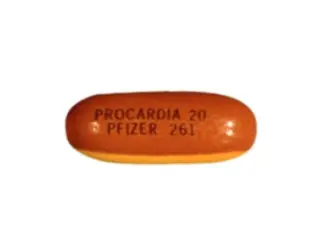| Package | Dosage | Price | Price per Dose | |
|---|---|---|---|---|
| Dosage: 10mg | ||||
| 360 pill | 10mg | £197.33 | £0.55 | |
| 180 pill | 10mg | £107.45 | £0.60 | |
| 120 pill | 10mg | £78.15 | £0.65 | |
| 90 pill | 10mg | £65.45 | £0.72 | |
| 60 pill | 10mg | £49.81 | £0.83 | |
| 30 pill | 10mg | £29.30 | £0.98 | |
| Dosage: 20mg | ||||
| 360 pill | 20mg | £235.43 | £0.65 | |
| 180 pill | 20mg | £129.92 | £0.72 | |
| 120 pill | 20mg | £97.68 | £0.81 | |
| 90 pill | 20mg | £84.01 | £0.93 | |
| 60 pill | 20mg | £63.49 | £1.06 | |
| 30 pill | 20mg | £40.04 | £1.35 | |
| Dosage: 30mg | ||||
| 180 pill | 30mg | £253.02 | £1.41 | |
| 120 pill | 30mg | £182.68 | £1.52 | |
| 90 pill | 30mg | £149.46 | £1.66 | |
| 60 pill | 30mg | £113.32 | £1.89 | |
| 30 pill | 30mg | £66.42 | £2.23 | |
| 10 pill | 30mg | £25.39 | £2.58 | |

Nifedipine Description
Introduction to Nifedipine
Nifedipine is a medication commonly used to treat various cardiovascular conditions, primarily hypertension (high blood pressure) and angina pectoris (chest pain). It belongs to a class of drugs known as calcium channel blockers. By relaxing the blood vessels, Nifedipine helps improve blood flow and reduce the workload on the heart. It is often prescribed when lifestyle changes alone are insufficient to manage blood pressure or anginal symptoms.
How Nifedipine Works
Nifedipine works by inhibiting the influx of calcium ions into smooth muscle cells lining the blood vessels. This action causes the muscles to relax, leading to vasodilation or widening of the blood vessels. As a result, blood pressure decreases, and the heart does not have to work as hard to pump blood through the body. This mechanism is effective in relieving chest pains caused by reduced blood flow to the heart muscle, a common feature of angina. Nifedipine's fast-acting formulations are also used to rapidly lower blood pressure in hypertensive emergencies.
Usage and Dosage
The usage of Nifedipine varies depending on the condition being treated. It is available in immediate-release and extended-release forms. For hypertension, the usual starting dose is often around 30 mg two or three times daily, but the dosage can be adjusted based on individual response. For angina, doses may range from 10 mg three times daily. It is crucial to follow a healthcare provider’s instructions precisely, as improper use can lead to adverse effects or inadequate disease control. Nifedipine is typically taken orally, with or without food, and consistency is essential for optimal results.
Possible Side Effects
While Nifedipine is generally well tolerated, some users may experience side effects. Common issues include dizziness, flushing, headaches, and swelling of the ankles or feet. Some individuals might also experience rapid heartbeat or nausea. Serious side effects are rare but can occur. These include allergic reactions, severe hypotension, or an irregular heartbeat. If any unusual or severe symptoms develop, immediate medical attention is necessary.
Precautions and Interactions
Before starting Nifedipine, it is important to inform your healthcare provider of any existing health conditions or medications. Nifedipine can interact with other drugs, such as beta-blockers, other antihypertensives, or medications affecting liver enzymes. Patients with certain conditions, like unstable angina or heart failure, should use Nifedipine cautiously. Pregnant or breastfeeding women should consult a doctor before use. Regular monitoring of blood pressure and heart rate is recommended during treatment to ensure safety and effectiveness.
Conclusion
Nifedipine remains a vital medication for managing high blood pressure and angina. Its ability to relax blood vessels makes it an effective agent in preventing cardiovascular complications. However, like all medications, it requires proper use under medical supervision to minimize risks and maximize benefits. Patients should adhere closely to their prescribed regimens and report any adverse effects promptly. When used appropriately, Nifedipine can significantly improve quality of life for individuals with cardiovascular issues.

